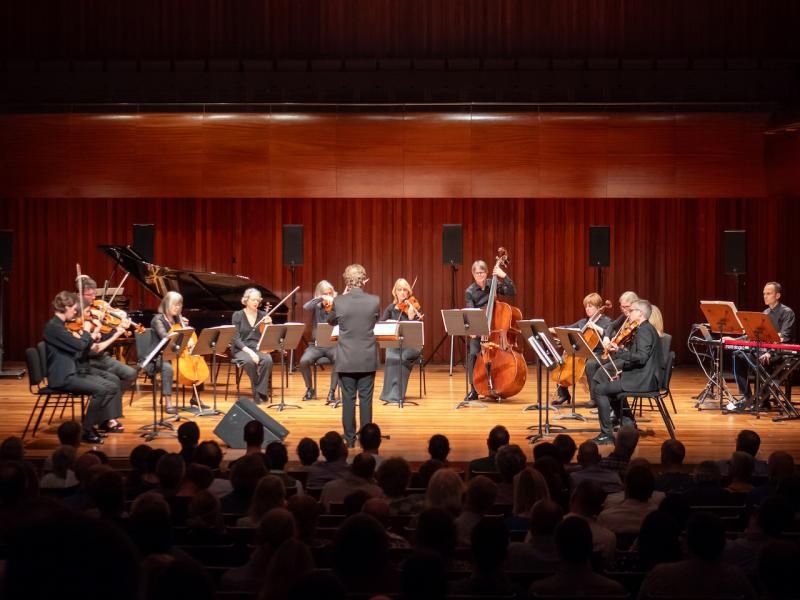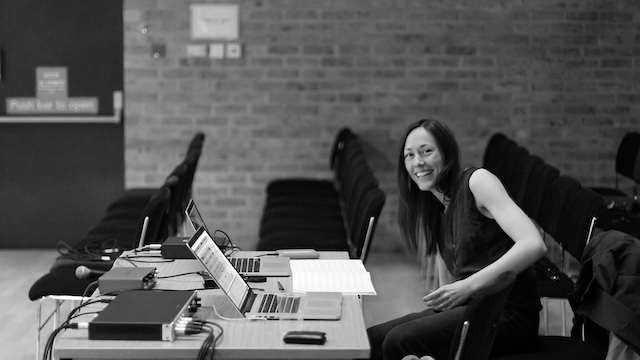Britten Sinfonia, The Marian Consort, Milton Court review - a journey around turbulent spirit Gesualdo | reviews, news & interviews
Britten Sinfonia, The Marian Consort, Milton Court review - a journey around turbulent spirit Gesualdo
Britten Sinfonia, The Marian Consort, Milton Court review - a journey around turbulent spirit Gesualdo
Contemporary homages among the works in this celebration of the Renaissance 'badass'

Gesualdo was, in the words of New Yorker critic Alex Ross – “irrefutably badass”, a double murderer, sado-masochist and black magic enthusiast who also found time to write music that was – according to some – centuries ahead of its time. He was the El Greco of sound, a rebel against perfectly balanced Renaissance proportions, who went on to influence cultural figures ranging from Stravinsky to Werner Herzog.
In Renaissance Moderns, performed by Britten Sinfonia and The Marian Consort, the 16th century Neapolitan composer was the dark beating heart of a programme that ranged from the 15th century works of Gilles Binchois to a European premiere by Lisa Illean. It began with the chamber orchestra playing Illean’s new arrangement for strings of Gilles Binchois’s song "Amours Merchi", an exquisite miniature which distilled his polyphonic original into interweaving lines of subtle, velvety sound.
Following this, members of the Marian Consort performed fellow fifteenth century composer John Dunstaple’s Regina Caeli, in which artistic director Rory McCleery’s countertenor in particular brought a piercing beauty to the sinuous, ascending harmonies.
Then the lights went down on the main part of the stage, so that pianist Huw Watkins was thrown into focus stage left. In the semi-darkness, he gave a thrilling performance of Thomas Adès’ Darknesse Visible, a 1992 piano adaptation of John Dowland’s infamous lute song "In Darknesse Let Me Dwell".
In this wonderful piece you get a full sense of the architectural vastness of the piano, as plangent double sforzando notes in the right and left hands are shaded by a tenebrous tremolo ranging across the central notes. At some levels it felt like a more extreme version of Debussy’s "La Cathédrale Engloutie", as cavernous rumbles echoed through the Steinway before resolving into the more meditative hymn-like ending.
The final work before the interval was Lisa Illean’s Arcing, Stilling, Bending, Gathering, which – as she explained in the programme – was initially inspired by two small films by Sergei Einstein that capture “fleeting reflections in glass shop windows”. The Britten Sinfonia – ably and sensitively led by violinists Thomas Gould and Charles Mutter – skilfully evoked the translucent layers of sound, which provided different perspectives on a theme only stated in the opening bars of the fourth and final movement.  To realise the vision of Illean (pictured above), the orchestra was divided into smaller chamber groups, with Philip Moore heightening the sense of refracted light through subtle electronic effects. After the sense of light and stillness in Arcing, there was ironically a greater sense of fluidity in Stilling, as the musicians tipped between passages that sounded like water dripping in an echoing building and rushes of notes that felt like a miniature waterfall. Bending introduced more uneasy dissonances, that evoked fears in the middle of the night and a world gently out of kilter. At the end of Gathering it seemed as if Illean was pushing the sound to the limits of the human hearing range as the violins whispered the piece to a close.
To realise the vision of Illean (pictured above), the orchestra was divided into smaller chamber groups, with Philip Moore heightening the sense of refracted light through subtle electronic effects. After the sense of light and stillness in Arcing, there was ironically a greater sense of fluidity in Stilling, as the musicians tipped between passages that sounded like water dripping in an echoing building and rushes of notes that felt like a miniature waterfall. Bending introduced more uneasy dissonances, that evoked fears in the middle of the night and a world gently out of kilter. At the end of Gathering it seemed as if Illean was pushing the sound to the limits of the human hearing range as the violins whispered the piece to a close.
While the first half of the evening was strong, with much to fascinate, the second half was stronger still, starting off with The Marian Consort’s performance of two 16th century works by the first published black composer, Vicente Lusitano. In the first song, "Heu Me Domine", the fantastic chromaticised harmonies maintained a jagged almost surreal tension throughout. For the more mellow "Allor che ignuda", the different voices wove in and out of each other with a subtle complexity similar to starlings in a murmuration.
After a brief interlude in which The Marian Consort’s artistic director, McCleery, explained how the more famous Gesualdo took at least some of the seeds of his inspiration from the unfairly neglected Lusitano, we had music from the reprobate himself. It began with Moro Lasso, a chromaticised work full of delicious dissonances that clearly tipped its hat to Lusitano. In the "Hei Mihi Domine", Caroline Halls’ soprano soared mesmerisingly over the other voices, like a hawk hovering in a pure blue sky, while in the powerfully morbid "Sparge La Morte", the darker harmonies, anchored by Christopher Webb’s resonant bass, tilted and swayed like a ship on a night-time sea.
The evening concluded with an electrifying performance of Brett Dean’s Carlo, written in 1997 and dedicated to Gesualdo’s music and turbulent life. It began with a recorded passage of Gesualdo’s "Moro Lasso", which became smudged and distorted, first by live pizzicato bass and cellos and then the rest of the orchestra. Over the course of the next 20 minutes it felt as if we had been swept up into a dreamscape in which snatches of sampled Gesualdo and vocalisations that sounded like the chittering of bats at dusk vied with the increasingly jagged accompaniment of the orchestra. It was ingenious, disturbing, and darkly beautiful – a resonant testimony to why Gesualdo continues to speak as much to our age as to his own.
rating
Explore topics
Share this article
The future of Arts Journalism
You can stop theartsdesk.com closing!
We urgently need financing to survive. Our fundraising drive has thus far raised £49,000 but we need to reach £100,000 or we will be forced to close. Please contribute here: https://gofund.me/c3f6033d
And if you can forward this information to anyone who might assist, we’d be grateful.

Subscribe to theartsdesk.com
Thank you for continuing to read our work on theartsdesk.com. For unlimited access to every article in its entirety, including our archive of more than 15,000 pieces, we're asking for £5 per month or £40 per year. We feel it's a very good deal, and hope you do too.
To take a subscription now simply click here.
And if you're looking for that extra gift for a friend or family member, why not treat them to a theartsdesk.com gift subscription?
more Classical music
 Goldscheider, Brother Tree Sound, Kings Place review - music of hope from a young composer
Unusual combination of horn, strings and electronics makes for some intriguing listening
Goldscheider, Brother Tree Sound, Kings Place review - music of hope from a young composer
Unusual combination of horn, strings and electronics makes for some intriguing listening
 theartsdesk Q&A: composer Donghoon Shin on his new concerto for pianist Seong-Jin Cho
Classical music makes its debut at London's K-Music Festival
theartsdesk Q&A: composer Donghoon Shin on his new concerto for pianist Seong-Jin Cho
Classical music makes its debut at London's K-Music Festival
 Helleur-Simcock, Hallé, Wong, Bridgewater Hall, Manchester review - moving lyricism in Elgar’s concerto
Season opener brings lyrical beauty, crisp confidence and a proper Romantic wallow
Helleur-Simcock, Hallé, Wong, Bridgewater Hall, Manchester review - moving lyricism in Elgar’s concerto
Season opener brings lyrical beauty, crisp confidence and a proper Romantic wallow
 Kohout, Spence, Braun, Manchester Camerata, Huth, RNCM, Manchester review - joy, insight, imagination and unanimity
Celebration of the past with stars of the future at the Royal Northern College
Kohout, Spence, Braun, Manchester Camerata, Huth, RNCM, Manchester review - joy, insight, imagination and unanimity
Celebration of the past with stars of the future at the Royal Northern College
 Jansen, LSO, Pappano, Barbican review - profound and bracing emotional workouts
Great soloist, conductor and orchestra take Britten and Shostakovich to the edge
Jansen, LSO, Pappano, Barbican review - profound and bracing emotional workouts
Great soloist, conductor and orchestra take Britten and Shostakovich to the edge
 Jakub Hrůša and Friends in Concert, Royal Opera review - fleshcreep in two uneven halves
Bartók kept short, and a sprawling Dvořák choral ballad done as well as it could be
Jakub Hrůša and Friends in Concert, Royal Opera review - fleshcreep in two uneven halves
Bartók kept short, and a sprawling Dvořák choral ballad done as well as it could be
 Hadelich, BBC Philharmonic, Storgårds, Bridgewater Hall, Manchester review - youth, fate and pain
Prokofiev in the hands of a fine violinist has surely never sounded better
Hadelich, BBC Philharmonic, Storgårds, Bridgewater Hall, Manchester review - youth, fate and pain
Prokofiev in the hands of a fine violinist has surely never sounded better
 Monteverdi Choir, ORR, Heras-Casado, St Martin-in-the-Fields review - flames of joy and sorrow
First-rate soloists, choir and orchestra unite in a blazing Mozart Requiem
Monteverdi Choir, ORR, Heras-Casado, St Martin-in-the-Fields review - flames of joy and sorrow
First-rate soloists, choir and orchestra unite in a blazing Mozart Requiem
 Cho, LSO, Pappano, Barbican review - finely-focused stormy weather
Chameleonic Seong-Jin Cho is a match for the fine-tuning of the LSO’s Chief Conductor
Cho, LSO, Pappano, Barbican review - finely-focused stormy weather
Chameleonic Seong-Jin Cho is a match for the fine-tuning of the LSO’s Chief Conductor
 Classical CDs: Shrouds, silhouettes and superstition
Cello concertos, choral collections and a stunning tribute to a contemporary giant
Classical CDs: Shrouds, silhouettes and superstition
Cello concertos, choral collections and a stunning tribute to a contemporary giant
 Appl, Levickis, Wigmore Hall review - fun to the fore in cabaret and show songs
A relaxed evening of light-hearted fare, with the accordion offering unusual colours
Appl, Levickis, Wigmore Hall review - fun to the fore in cabaret and show songs
A relaxed evening of light-hearted fare, with the accordion offering unusual colours
 Lammermuir Festival 2025, Part 2 review - from the soaringly sublime to the zoologically ridiculous
Bigger than ever, and the quality remains astonishingly high
Lammermuir Festival 2025, Part 2 review - from the soaringly sublime to the zoologically ridiculous
Bigger than ever, and the quality remains astonishingly high

Add comment